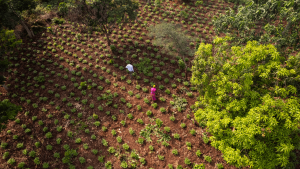Agroforestry represents a powerful approach to sustainable agriculture and land restoration, but it also holds great potential for empowering communities.
What is Agroforestry?
Agroforestry is the practice of integrating trees and shrubs into agricultural landscapes. This approach empowers communities in several impactful ways. By incorporating trees into farming systems, communities can diversify their income sources. Trees provide valuable products such as fruits, nuts, and timber, reducing dependence on a single crop and mitigate the risks associated with market fluctuations or crop failures.

Enhancing Soil health and Sustainability
Agroforestry practices improve soil fertility, reduce erosion, and enrich the soil with nutrients like nitrogen. This results in more productive and sustainable land use, empowering communities to manage their natural resources more effectively.
Empowering Women Through Agroforestry
Agroforestry systems also significantly benefit women by providing easier access to resources such as firewood and animal fodder, which are often traditionally women’s responsibilities to gather. With more time and resources at their disposal, women are better positioned to participate in household and community decision-making processes.

Preserving Traditional Knowledge
Agroforestry systems often combine modern science and traditional ecological knowledge. Promoting these practices empowers communities to maintain and revitalise their traditional agricultural practices and integrate them into their local contexts.
Community Involvement and Ownership
Agroforestry projects often involve active participation from local communities in planning, implementation, and management. When communities have a stake in the project’s success and are involved in decision-making processes, a sense of ownership and empowerment is fostered.
Overall, agroforestry empowers communities by diversifying income sources, improving productivity, empowering women, and fostering community ownership. These aspects contribute to building more sustainable and resilient agricultural systems, which are essential for long-term food security and livelihood sustainability.
